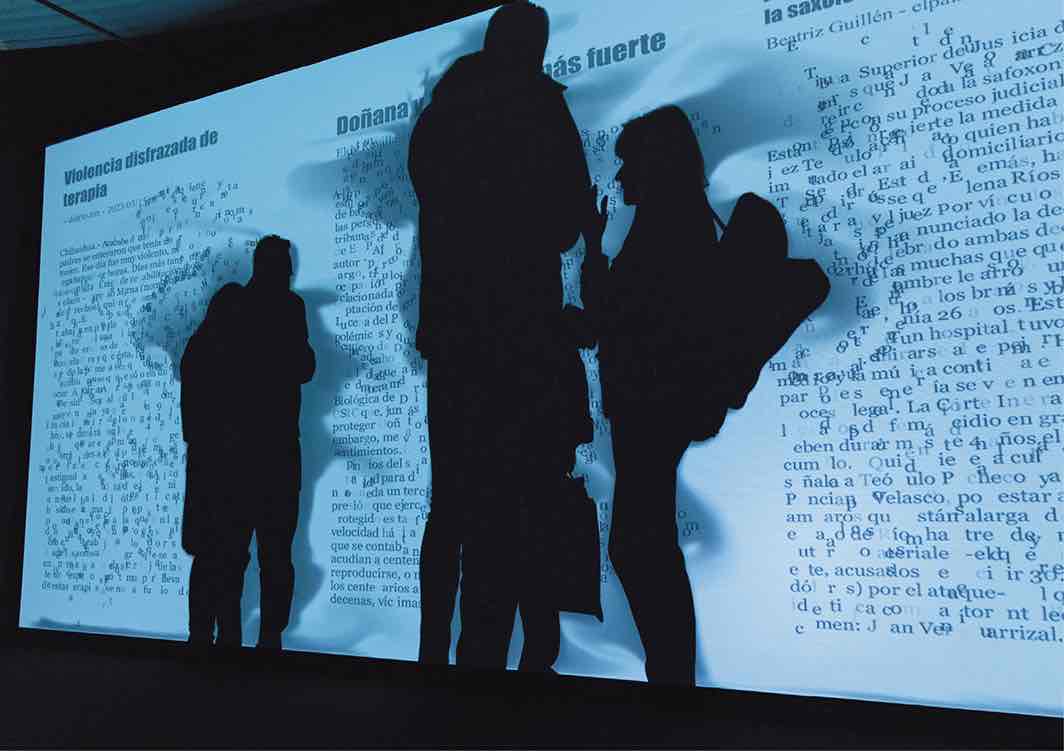
—by Maria Porges
Rafael Lozano-Hemmer is one of those rare artists who both understands complex technologies and can harness them to make works of art that are, miraculously, not only smart but spectacularly visually compelling. The eleven pieces on view in this exhibition at Gray Area spanned nearly twenty years, reflecting a variety of Lozano-Hemmer’s interests and concerns, such as immigration and border politics, the creative subversion of tech used primarily for policing or militaristic purposes, and the need to dismantle ideas surrounding white Eurocentrism and US exceptionalism. (Having emigrated as a teenager from Mexico to Canada, Lozano-Hemmer has a unique perspective on cultural/continental divisions, whether they are practical, poetical, or utterly nonsensical.) A central focus—as expressed by the show’s title, “TECHS-MECHS: A Survey of Mexican Technological Culture”—was the idea of calling into question the narrative regarding Silicon Valley’s dominance over innovation.
The largest piece in the show was the immersive Pulse Topology, 2021, a wavelike grid of three thousand lightbulbs suspended from the ceiling. The work suggests both an upside-down landscape and a three-dimensional EKG, twinkling in response to the heartbeats of both past and current visitors. Three downlights marked spots where you could hold your hand out until your own pulse took over a portion of the work’s rhythm, visually and aurally, until it was superseded, absorbed, and catalogued for inclusion into the installation’s nearby servers, which were filled with thousands of other examples. At the start of this process, a single bulb glowed brightly—like an incandescent memento mori—and then became absorbed by the other flashing lights around it until the heartbeats of three thousand more spectators were recorded.
This representation of “hearts beating as one” was enchanting, even as it reminded viewers of the brevity of human life. The sense of ephemerality was also foregrounded in Airborne Newscasts, 2013, in which a silhouette rendering of a viewer’s body heat, cast onto a theatrically scaled white screen, disrupted projections of live news bulletins, turning them into nonsensical eddies of letters. With a kind of exquisite generosity, Lozano-Hemmer gave viewers a chance to short-circuit their own automatic response of seeing and reading, as the transmissions put out by AlterNet, Fox, La Jornada, Notimex, and other networks dissolved into illegibility. Between these messages were stories of Mexican scientists and intellectuals whose discoveries and contributions have been hidden (or attributed to US citizens). These stories were similarly altered by the silhouettes, implying a digital colonialism.
Throughout the show, data were performed in a visible and even at times viscerally tangible way. In Sway, 2016, a stiffened, roughly seven-foot-tall version of a rope noose—a longtime symbol of American violence and ruthless vigilantism—was quixotically presented upside down. A complex metronomic mechanism gave it a subtle back-and-forth movement, the frequency of which was determined by a statistic chosen by curators at the venue where the work was being presented. In this case, the tiny sway every three or four minutes represented the frequency of Immigration and Customs Enforcement (ICE) arrests in 2021.
It’s possible to experience much of Lozano-Hemmer’s work innocently, but its astonishing formal beauty serves as a Trojan horse for the social and political commentary with which the artist imbues everything. The big ideas that animate Lozano-Hemmer’s output give it intellectual heft and poignancy, but we are not bombarded. With great skill and an even greater beneficence, he leaves enough room for each viewer to enter the art on their own terms. He allows us to choose our own adventure, knowing that we’ll eventually get to the message at the center of it all.

